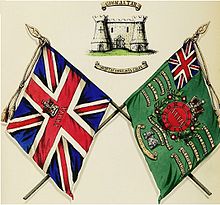39th Regiment of Foot
| 39th (Dorsetshire) Regiment of Foot | |
|---|---|

Colours of the 39th Foot
|
|
| Active | 1702 to 1881 |
| Country |
|
| Branch |
|
| Type | Infantry |
| Size | One battalion (2 battalions 1803–1815) |
| Garrison/HQ | Dorchester Barracks, Dorchester |
| Nickname(s) | "Shankey's Horses" , "The Green Linnets", "The Flamers". |
| Colors | Pea Green Facings, Gold Braided Lace |
| Engagements |
War of the Spanish Succession War of the Austrian Succession Seven Years' War French Revolutionary Wars Napoleonic Wars Coorg War Gwalior Campaign Crimean War |
The 39th (Dorsetshire) Regiment of Foot was an infantry regiment of the British Army, formed in 1719. It amalgamated with the 54th (West Norfolk) Regiment of Foot to form the Dorsetshire Regiment in 1881.
The regiment was first raised by Adam Loftus, 1st Viscount Lisburne as Viscount Lisburne's Regiment of Foot in 1689 but was disbanded in 1697. It was re-raised in Ireland, without lineal connection to the previous regiment, by Colonel Richard Coote as Richard Coote's Regiment of Foot in August 1702. The regiment landed at Lisbon in June 1707 for service in the War of the Spanish Succession. It saw action at the Battle of La Gudina in May 1709 and then remained in Portugal until 1713 when it embarked for Gibraltar and then moved to Minorca later in the year. It was posted to Ireland in 1719 and sailed to Gibraltar in 1726 to reinforce the garrison. The regiment sailed for Jamaica in 1729 and then returned to Ireland in 1732.
The regiment served as marines from March 1744 to September 1746 when it took part in the Raid on Lorient during the War of the Austrian Succession. The regiment then spent another two years serving as marines and then returned to Ireland. On 1 July 1751 a royal warrant was issued which provided that in future regiments would no longer be known by their colonel's name, but would bear a regimental number based on their precedence: the regiment became the 39th Regiment of Foot. The regiment was posted to India in 1754 and saw action at the Battle of Chandannagar in March 1757 during the Seven Years' War. Under the command of Major Eyre Coote, the regiment played a major part in capturing the fort of Katwa at the Battle of Plassey in June 1757. The regiment returned to Ireland in autumn 1758 and was engaged in the Great Siege of Gibraltar in 1779 and the following three years.
...
Wikipedia
